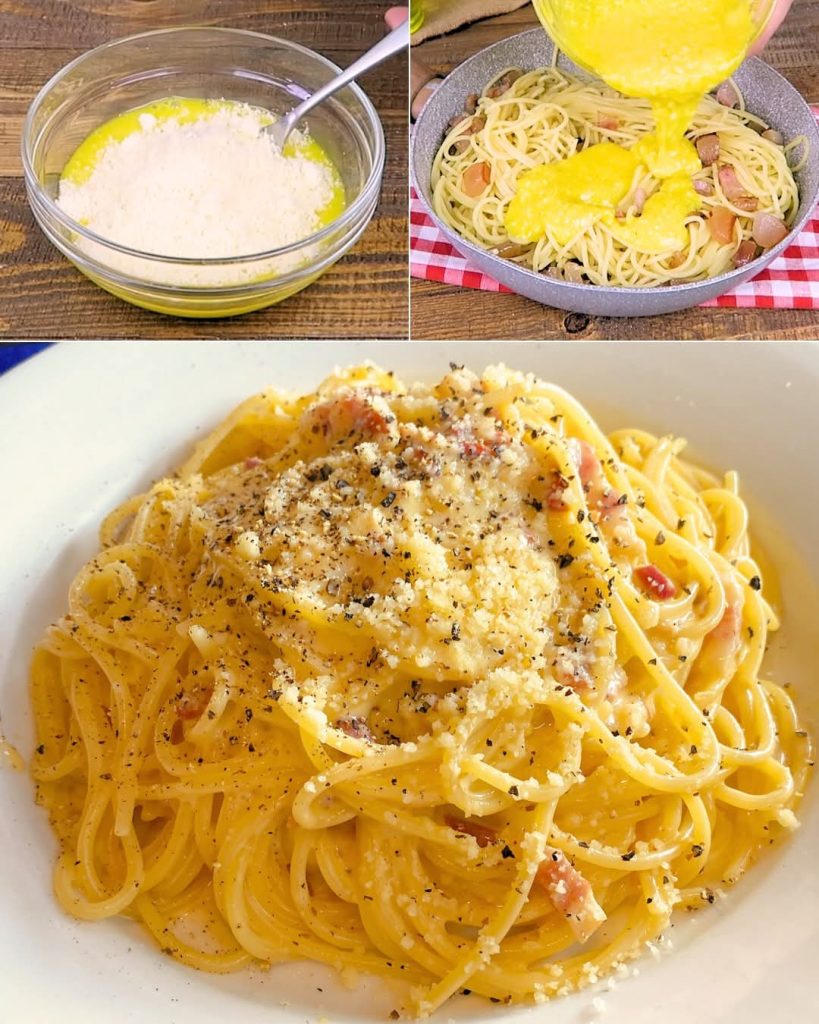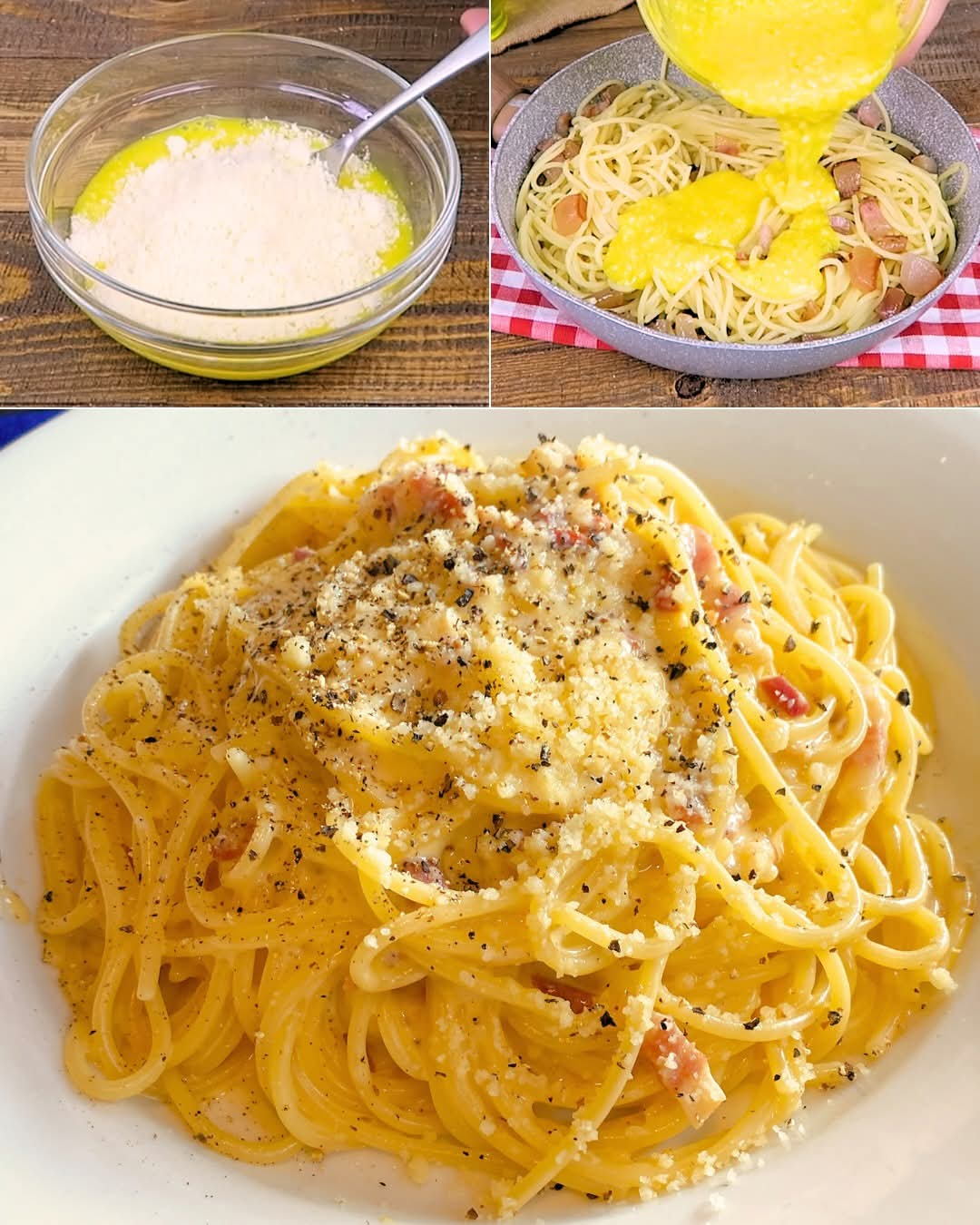
Spaghetti alla Carbonara – The Full, Big Recipe Guide
1. Introduction
Spaghetti alla Carbonara is a culinary masterpiece from Italy’s Lazio region, particularly Rome. It’s a dish that celebrates the art of simplicity: spaghetti tossed with crispy guanciale, velvety egg sauce, sharp Pecorino Romano, and freshly ground black pepper. There’s no cream—its creamy texture comes purely from the magical emulsion of egg, cheese, and pasta water.
Carbonara is more than a recipe—it’s a symbol of Italian cooking philosophy: use a few high-quality ingredients, treat them with respect, and let them shine. It’s comforting yet sophisticated, quick to prepare yet worthy of the finest Italian trattoria.
2. History
Origin stories:
- Roman tradition – Many believe Carbonara evolved from the meals of shepherds in the Apennine Mountains who carried dried pasta, cured pork, and hard cheese on long trips.
- WWII influence – Another theory says Carbonara was born during the liberation of Rome in 1944, when American soldiers brought bacon and powdered eggs, which Italians adapted using their pasta traditions.
- Name origin – The word carbonara could come from carbonaro, meaning charcoal burner, implying it was a hearty meal for workers. Another theory links it to the specks of black pepper resembling coal dust.
Today, Carbonara is an icon of Roman cuisine, fiercely protected by purists who insist on sticking to the original ingredients: guanciale, eggs, Pecorino Romano, black pepper, and pasta.
3. Ingredients (Serves 4)
400 g (14 oz) spaghetti – Use bronze-cut for better sauce adhesion.
150 g (5 oz) guanciale – Cured pork cheek; pancetta can be substituted but changes flavor.
3 large egg yolks – For richness.
1 whole large egg – Adds creaminess and stability.
100 g (3.5 oz) Pecorino Romano, finely grated – Sharp, salty sheep’s milk cheese.
Freshly ground black pepper, to taste.
Coarse salt – For pasta water (about 10 g per liter of water).
4. Preparation Steps
Step 1 – Make the egg-cheese mixture
- In a medium mixing bowl, whisk together the yolks, whole egg, Pecorino Romano, and a generous amount of black pepper until smooth and creamy. Set aside.
Step 2 – Cook the pasta
Boil water in a large pot and salt it well. Add spaghetti and cook until al dente according to package instructions.
Reserve at least 1 cup of pasta water before draining.
Step 3 – Cook the guanciale
Place guanciale in a large skillet over medium heat (no oil needed; the fat will render).
Cook until golden and crisp, about 5–7 minutes. Remove the skillet from direct heat to prevent overcooking.
Step 4 – Combine pasta and guanciale
- Transfer the drained pasta to the skillet with guanciale and toss well so every strand is coated with the rendered fat.
Step 5 – Create the creamy sauce
- Remove the skillet from heat to avoid scrambling eggs. Pour in the egg-cheese mixture and toss quickly and vigorously, adding splashes of pasta water until a smooth, glossy sauce forms.
Step 6 – Plate and garnish
- Serve immediately with extra Pecorino Romano and freshly ground black pepper.
5. Method Notes & Chef’s Tips
Temperature control is key: combine the egg mixture with pasta off the heat.
Pasta water magic: The starchy liquid is essential for emulsifying the sauce.
Use the right cheese: Pecorino Romano has a sharper flavor than Parmesan.
Cut guanciale thick: About 1 cm cubes give a better texture.
6. Formation (Science Behind the Sauce)
When you mix hot pasta with the egg-cheese blend and fat from guanciale, heat gently cooks the eggs, while starch in pasta water binds with fat to create a silky emulsion. The result? Creaminess without cream.
7. Benefits
Rich in protein from eggs and guanciale.
High in calcium from Pecorino Romano, supporting bone health.
Energy-boosting carbohydrates from pasta.
Good fats from cured pork in moderation.
Mood-lifting—because creamy pasta makes life better.
8. Lovers of the Dish
Romantics: Carbonara is a popular date-night meal—comforting, intimate, and indulgent.
Travelers: Visitors to Rome often fall in love with the authentic version.
Food purists: Love the tradition and authenticity of its preparation.
9. Nutritional Information (Per serving, approx.)
Calories: 520 kcal
Protein: 22 g
Fat: 22 g
Saturated Fat: 9 g
Carbohydrates: 56 g
Fiber: 3 g
Sodium: 720 mg
10. Variations
Carbonara di Mare – Replace guanciale with smoked salmon or prawns.
Vegetarian – Use sautéed mushrooms instead of meat.
Gluten-Free – Use gluten-free spaghetti.
11. Conclusion
Spaghetti alla Carbonara is proof that perfection doesn’t require complexity. With just a handful of ingredients and a bit of technique, you can create a dish that’s indulgent, elegant, and deeply satisfying. It’s Italy’s gift to pasta lovers worldwide.
12. Lovers (Final Word)
From the bustling trattorias of Rome to cozy home kitchens, Carbonara continues to inspire devotion. For many, the first bite is love at first taste—a creamy, peppery embrace that keeps calling you back.
